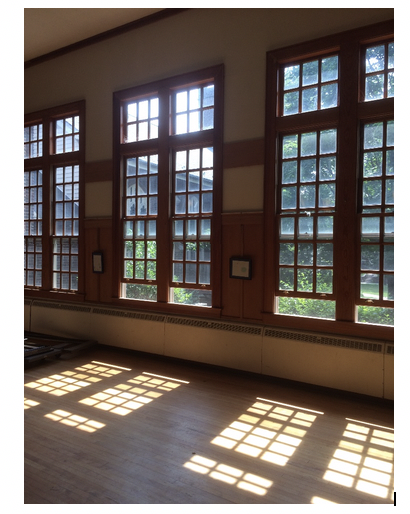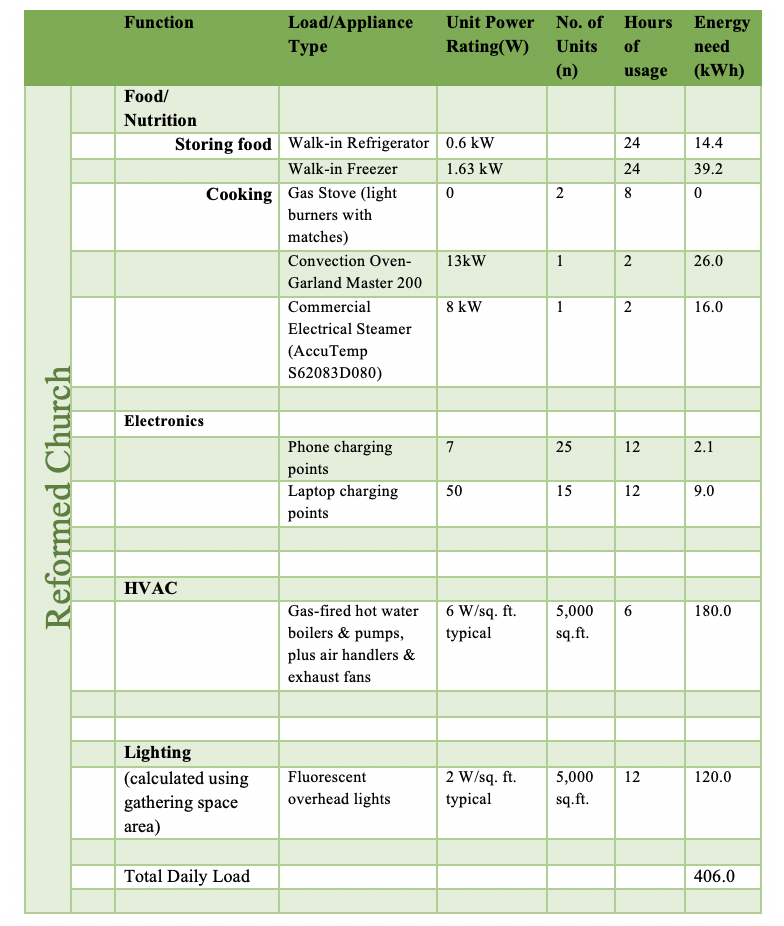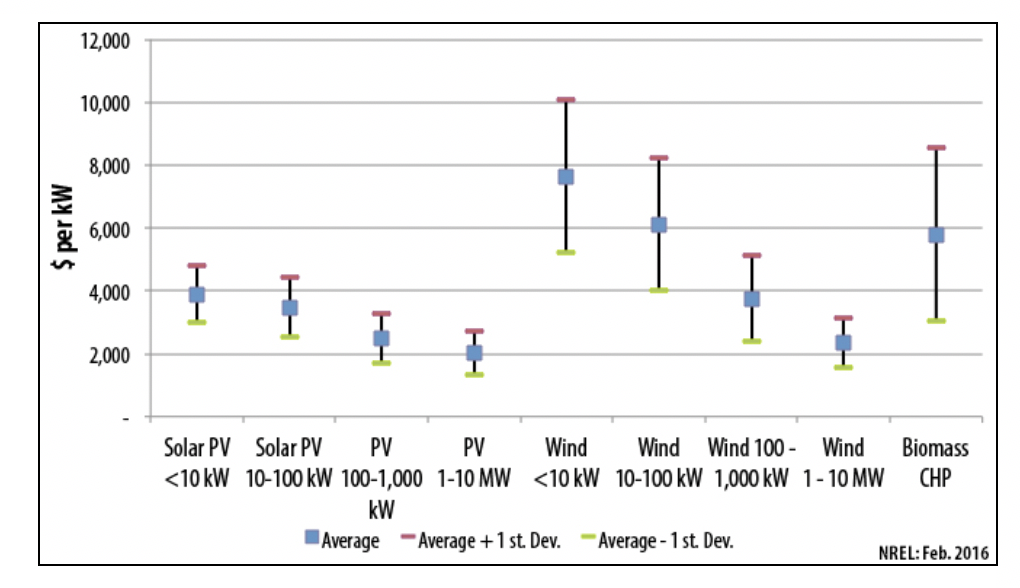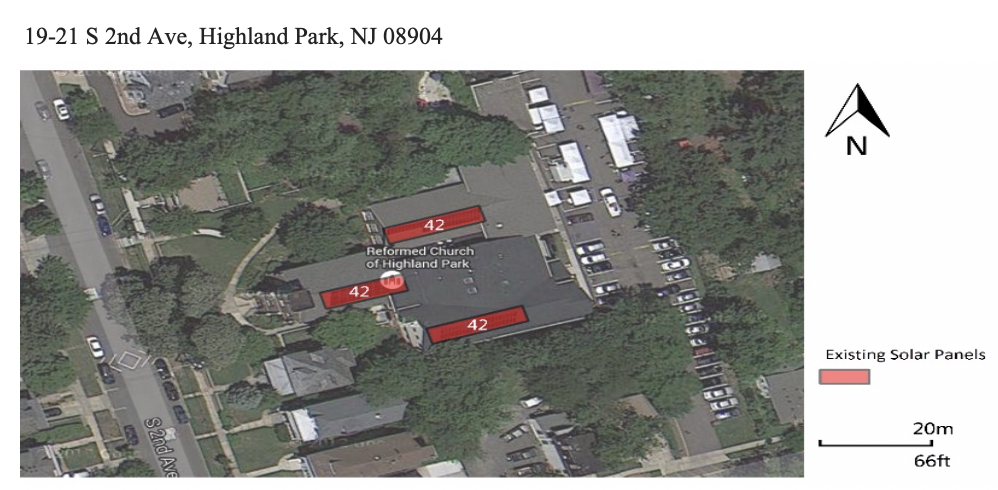Highland Park Reformed Church Solar Islanding Study
Highland Park, NJThe Highland Park Reformed Church was one of three potentials sites for community shelters studied as part of the Highland Park Solar Islanding Project (2015). The site fulfills at least some of the desirable traits of an emergency shelter and provides examples of community resiliency planning at the building level.
Why is it important?
Superstorm Sandy affected Highland Park and many other places following its landfall in October 2012. Among the most severe impacts for Highland Park residents were electric power outages lasting up to two weeks for portions of the municipality. This experience highlighted a need to better prepare for similar situations in the future.
A set of community gathering spaces can be equipped with the capability of supporting basic functions for community residents whose homes have lost power or are otherwise uninhabitable. Sheltered spaces are needed so that residents can rest comfortably, charge their phones, and have access to basic heating and cooking facilities enabled by resilient sources of electric power.
Solar arrays outfitted with battery storage and islanding inverters can be expected to provide emergency “power islands” during times of storm or other grid outages. When implemented in community meeting places that can function independently of the grid, solar islanding increases community resiliency. In the Highland Park Reformed Church case study, the existing solar arrays if converted to solar power islands would be able ‘to provide only modest emergency’ power.
Available energy also depends on season and system engineering specifications. Thus, a critical step in planning for solar islanding capabilities is to analyze power demands and associated functions that benefit from solar islanding.
Figure 1 – Reformed Church Site
For Whom is This Useful?
Because solar islanding has the potential to improve community resiliency, the following case study is most useful to municipalities and institutional building owners motivated to prepare community spaces for future power outages. Such institutional buildings might include schools and community shelters.
Summary of Location and Resiliency Characteristics: Reformed Church
The Reformed Church is more than 120 years old and the complex includes sections built over many decades. As a result, the electric system is segmented and should be easy to rewire the circuits to serve critical loads for emergency scenarios.
The complex has a strong record of serving as an emergency gathering place and hosted large numbers of displaced community residents during Sandy.
The community room (Social Hall) of the church is equipped with a full kitchen and dozens of portable cots for overnight emergency guests. Its floor area is approximately 5,000 square feet.
A field visit to the Reformed Church (4/29/15, 11:00 am, sunny) confirmed that two rooftop solar arrays serve the church complex, one on the church roof and the other on the attached residence for young woman aging out of foster care. They appear to be 2 x 6,400 W arrays. They have a shared savings program with Sun Farm Network to pay back the $110k investment through their electricity bills over time.
A natural gas-fired hot water boiler provides heating with electric circulating pumps. Domestic hot water and cooking equipment are also natural gas-fired. The dishwasher and refrigerators require electricity.

Figure 2 – Street Entrance from S. 2nd Ave (left). Rack mounted solar panels (42 X 102W) atop one of the 3 buildings at the Reformed Church (right)

Figure 3 – Gathering space at Reformed Church – Social Hall
Electricity Demand Calculation
Three questions were posed to determine critical electrical loads in the study:
- Must it be continuously available?
- Are there any affordable and convenient substitutes?
- What are the consequences for human health and economic costs?
As seen in the High School/Middle School case study, the electricity demand associated with HVAC, lighting, and cooking can be quite high (see Table 1). These uses may require paring back significantly during an outage situation where the solar system plays the predominant energy supply role. A reasonable level of electricity demand could provide phone and computer charging, and emergency lighting. Cooking could rely chiefly on natural gas-fired equipment.
The Reformed Church is owned and operated by a nonprofit religious organization. It is not a part of the municipal government or the school district. It raises revenue mostly from donations, and its ability to take on debt is limited. It must meet building codes, but it does not need to follow governmental procurement processes and hence can act nimbly. The church leadership can pursue donations, grants, and third-party financing to acquire solar islanding capability.

Table 1 – Electricity Demand Calculation for Reformed Church Social Hall – 12 hours.
Cost Projections
A resilient system solution to enable sheltering capabilities at the Reformed Church would combine substantial solar photovoltaic generation with reasonably sized battery storage on site, both of which are sizeable investments.
Grid-tied solar arrays have a long history, and the costs have been coming down gradually with time, as competitive market factors have had their effect. Figure 1 shows data on costs for different kinds of renewable generation sources. The most relevant match to the systems Highland Park might consider would be the “PV 100-1,000” data point, which translates to about $3.5 to $4 per Watt, installed. This price includes the inverter, fixtures, and wiring. Parking structure arrays are probably a somewhat higher cost as they involve very sturdy designs intended to withstand very high winds. These systems might be $5/W or more, depending on the configuration.
Battery systems installed to provide resilient power backup have less track record. Also, retrofit projects added onto existing solar require an upgrade to the existing power inverter for the system. Newer inverters can provide the islanding capability not designed into the earlier New Jersey installations.

Figure 4 – Solar array installed costs for different system sizes (Source: NREL Energy Analysis. 2016)
Funding Opportunities
New Jersey is committed to a renewable energy future, and incentives for renewable energy development often are available. For the most up-to-date information on renewable energy policy and incentive structures, visit the NJ Board of Public Utilities website http://www.bpu.state.nj.us/.
Resources
Highland Park Solar Islanding Project (2015). Prepared for the Borough of Highland Park, NJ by Jennifer Senick, Executive Director, Rutgers Center for Green Building; Dunbar Birnie, Professor of Ceramic Engineering, Department of Materials Science and Engineering; Aman Trehan, Research Graduate Assistant; Nan Chen, Research Graduate Assistant; Deborah Plotnik, Program Coordinator, Rutgers Center for Green Building, Rutgers – The State University of New Jersey.
Related Strategies
- Combined Heat and Power (CHP)
- Demand Response and Peak Load Management
- Emergency Water Supply and Storage
- Energy Star Equipment and Plug Loads
- On-site Renewable Energy Systems
- Roof Replacements and Upgrades
- Smart Metering
- Solar Islanding and Micro-Grid Ready Solar PV
- Storm Preparation and Emergency Planning
- Thermal Energy Storage

